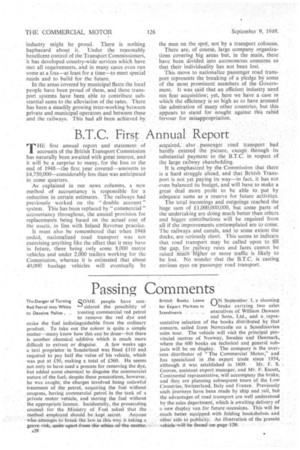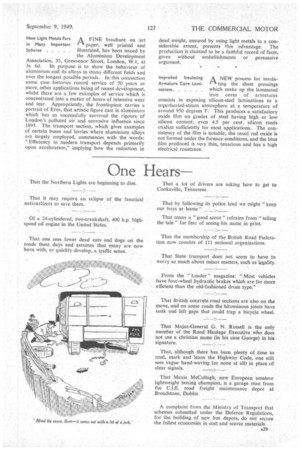Passing Comments
Page 30

Page 31

If you've noticed an error in this article please click here to report it so we can fix it.
The Danger of Turning qamE people have conRed Petrol into White " sidered the possibility of to Deceive Police, . treating commercial red petrol
to remove the red dye and make the fuel indistinguishable from the ordinary product. To take out the colour is quite a simple matter—many. know haw this can be done—but there is another chemical additive which is much more
difficult to extract or disguise. A few weeks ago a taxi proprietor in Sunderland was fined £,310 and required to pay half the value of his vehicle, which was put at £50, making a total of £360. Be seems not only to have used a process for removing the dye, but added some chemical to disguise the commercial nature of the fuel; despite these precautions, however, he was -caught, the charges involved being unlawful treatment of the petrol, acquiring the fuel without coupons, having commercial petrol in the tank of a private motor vehicle, and storing the fuel without the appropriate licence. Incidentally, the prosecuting counSel fort the Ministry of Fuel asked that the method .employed should -be _kept. secret; Anyone who-attempts to break the law. in this way.is taking-a graverisk, -quite apart-fromthe ethicsof-the matter,. British Books Leave ntsi September 3, a shooting for Export Markets in ‘-"brake carrying two sales Scandinavia . . executives of William Dawson and Sons, Ltd., and a, representative selection of the books distributed by that concern, sailed from Newcastle on a Scandinavian sales tour. The vehicle will visit the principal provincial centres of Norway, Sweden and Denmark, where the 600 books on technical and general subjects will be on display. The company is the overseas distributor of "The Commercial Motor,' and has specialized in the export trade since. 1934, although it was established in 1809. Mr. F. S. Groves, assistant export manager, and Mr. F. Escott, Continental representative, will accompany the brake, and they are planning subsequent tours of the Low Countries, Switzerland, Italy and France. Previously such journeys have been made by ship and rail, hut the advantages of road transport are well understood by the sales department, which is awaiting delivery of a new display van for future occasions. This will be much better equippedwith folding bookshelves and Other aids to publicity: An illustration of the present vehicle -wiWbe found. onpage 12R. A FINE brochure on art " paper, well printed and illustrated, has been issued by the Aluminium Development Association, 33, Grosvenor Street, London, W.1, at 3s. 6d. Its purpose is to show the behaviour of aluminium and its alloys in many different fields and over the longest possible periods. In this connection some case histories record service of 50 .years or more, other applications being of recent development, whilst there are a few examples of service which is concentrated into a matter of hours of intensive wear and tear. Appropriately, the frontispiece carries a portrait of Eros, that artistic figure cast in aluminium which has so successfully survived the rigours of London's polluted air and corrosive influence since 1893. The transport section, which gives examples of certain buses and lorries where aluminium alloys are largely employed, commences with the words: "Efficiency in modern transport depends primarily upon acceleration," implying how the reduction in
How Light Metals Fare in Many Important Spheres
dead weight, ensured by using light metals to a considerable extent, presents this advantage. The production is claimed to be a faithful record of facts, given without embellishments or persuasive argument.
Im prched Insulating A NEW process for insula Armature Core Lamiting the sheet pressings nations which make up the laminated
iron cores of armatures consists in exposing silicon-steel laminations to a superheated-steam atmosphere at a temperature of around 950 degrees F. This produces a satisfactory oxide film on grades of steel having high or low silicon content, even 4.5 per cent. silicon steels oxidize sufficiently for most applications. The consistency of the film is notable; the usual red oxide is not farmed under the furnace conditions, and the blue film produced is very thin, tenacious and has a high electrical resistance.




























































































